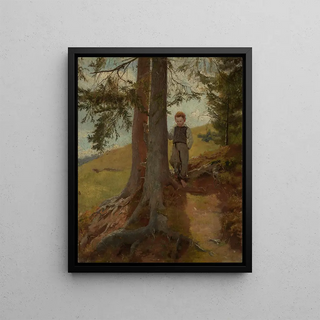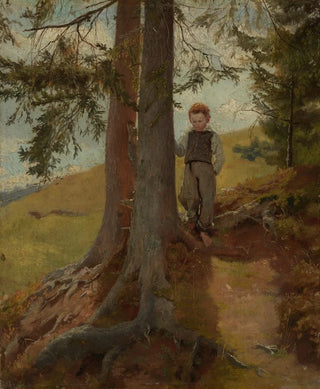Farm boy at the edge of the forest - Hans Thoma Art print


View from behind

Frame (optional)
The art print "Farm Boy at the Edge of the Forest" by Hans Thoma invites a sensory journey into the heart of German nature. This piece, created at the end of the 19th century, evokes an atmosphere of peace and serenity, where childhood innocence blends with the majesty of the landscape. The boy, the central figure of the composition, appears in harmony with his environment, embodying the simplicity and beauty of rural life. Through this art print, the viewer is transported to a world where time seems to stand still, offering a contemplative pause amid our busy modern lives.
Style and uniqueness of the work
Hans Thoma's style is distinguished by its naturalist approach, combined with poetic sensitivity. In "Farm Boy at the Edge of the Forest," he manages to capture light in an almost magical way, rendering the nuances of green foliage and brown farmland with vibrant clarity. The way he depicts the boy, with softness and delicacy, demonstrates mastery of forms and colors. The meticulous details, such as the play of shadow and light, add an almost tactile dimension to the piece, allowing the viewer to feel the freshness of the air and the whisper of the leaves. Thoma succeeds in creating an atmosphere where nature and humanity coexist in perfect harmony, a recurring theme in his work.
The artist and his influence
Hans Thoma, born in 1839 in Germany, is often associated with the late Romantic movement. His artistic career is marked by a deep connection with nature, which he considers an inexhaustible source of inspiration. Thoma was able to establish himself in the artistic landscape of his time thanks to his ability to marry tradition and innovation. His works, often imbued with a spiritual dimension, have influenced many contemporary and later artists. He also played a key role in the rediscovery of German painting in the 19th century, highlighting themes related to national identity and popular culture. His artistic vision, which celebrates rural life and human values, continues to resonate.

Matte finish

View from behind

Frame (optional)
The art print "Farm Boy at the Edge of the Forest" by Hans Thoma invites a sensory journey into the heart of German nature. This piece, created at the end of the 19th century, evokes an atmosphere of peace and serenity, where childhood innocence blends with the majesty of the landscape. The boy, the central figure of the composition, appears in harmony with his environment, embodying the simplicity and beauty of rural life. Through this art print, the viewer is transported to a world where time seems to stand still, offering a contemplative pause amid our busy modern lives.
Style and uniqueness of the work
Hans Thoma's style is distinguished by its naturalist approach, combined with poetic sensitivity. In "Farm Boy at the Edge of the Forest," he manages to capture light in an almost magical way, rendering the nuances of green foliage and brown farmland with vibrant clarity. The way he depicts the boy, with softness and delicacy, demonstrates mastery of forms and colors. The meticulous details, such as the play of shadow and light, add an almost tactile dimension to the piece, allowing the viewer to feel the freshness of the air and the whisper of the leaves. Thoma succeeds in creating an atmosphere where nature and humanity coexist in perfect harmony, a recurring theme in his work.
The artist and his influence
Hans Thoma, born in 1839 in Germany, is often associated with the late Romantic movement. His artistic career is marked by a deep connection with nature, which he considers an inexhaustible source of inspiration. Thoma was able to establish himself in the artistic landscape of his time thanks to his ability to marry tradition and innovation. His works, often imbued with a spiritual dimension, have influenced many contemporary and later artists. He also played a key role in the rediscovery of German painting in the 19th century, highlighting themes related to national identity and popular culture. His artistic vision, which celebrates rural life and human values, continues to resonate.






